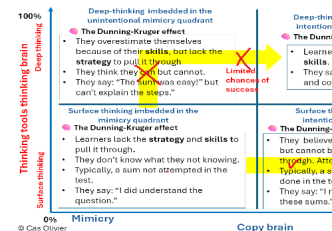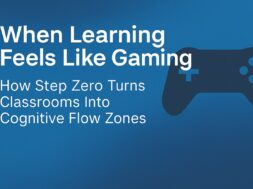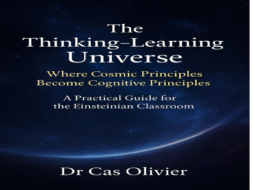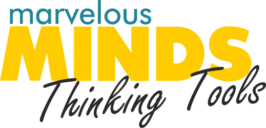"The sum was easy!" the learner says—yet fails to explain a single step. If you’re a teacher, you’ve heard this many times. This isn't laziness or defiance. It's often a classic case of the Dunning–Kruger effect, where learners overestimate what they know and underestimate what they still need to learn.
But in a brain-based classroom built around Thinking Tools, we can map this effect in a far more practical way—one that helps both teacher and learner take action.
What is the Dunning–Kruger Effect?
In short: people with low ability in a domain tend to overrate their competence, while those with high ability often underrate theirs. It has everything to do with self-awareness and cognitive maturity.
In education, this means learners may feel falsely confident, or they may miss how close they are to true mastery.
From Curve to Classroom: My Four-Quadrant Model
Instead of just showing the Dunning–Kruger curve, I developed a four-quadrant model that combines:
- Surface vs. Deep Thinking (vertical axis)
- Mimicry vs. Intentional Imitation (horizontal axis)
Here’s how each quadrant plays out with real learners:
🧠 Top Left: Deep Thinking + Mimicry
The illusion of competence
- Learners overestimate their skills, but lack the strategy to solve problems.
- They say: “The sum was easy!” but can’t explain the steps.
- They’re confident but cannot reproduce the result.
- Chances of success: Low
🧠 Bottom Left: Surface Thinking + Mimicry
- Unconscious incompetence
- Learners lack both skill and strategy.
- They don’t even know what they don’t know.
- They say: “I did understand the question.” But they didn’t attempt it.
- This is the danger zone of mimicry-only learning.
🧠 Bottom Right: Surface Thinking + Intentional Imitation
False sense of readiness
- Learners have some strategies, but not enough skill to apply them.
- They often skip steps because they think they understand.
- They say: “I never know where to start with these sums.”
- They believe they can, but they can’t.
🧠 Top Right: Deep Thinking + Intentional Imitation
True competence and clarity
- Learners have both the strategy and the skill.
- They say: “I understood the sum and could pull it through.”
- Performance is reliable and self-aware.
- Chances of success: High
WHY THIS MATTERS
In traditional classrooms, many learners live in the false-confidence zone. They mimic the teacher or the textbook but can’t transfer knowledge. Thinking Tools change that. By making thinking visible, we move learners intentionally from mimicry toward mastery.
And that’s where the real Dunning–Kruger shift happens:
From "I think I know" to "Now I can explain what I know."
Final Thought
If you want your learners to move from surface to deep thinking—from overconfidence to competence—then understanding where they are on this map is essential.
In our Thinking Tools training, we equip teachers to:
- Diagnose these Dunning–Kruger patterns early
- Use visual tools like Tree Maps and Bridge Maps to build strategy
- Create intentional transitions from mimicry to metacognition
Let’s replace illusion with insight. And move from mimicry to mastery.
Want to learn more? Join our next Thinking Tools course or contact us for team-based training that transforms classrooms from the inside out.





